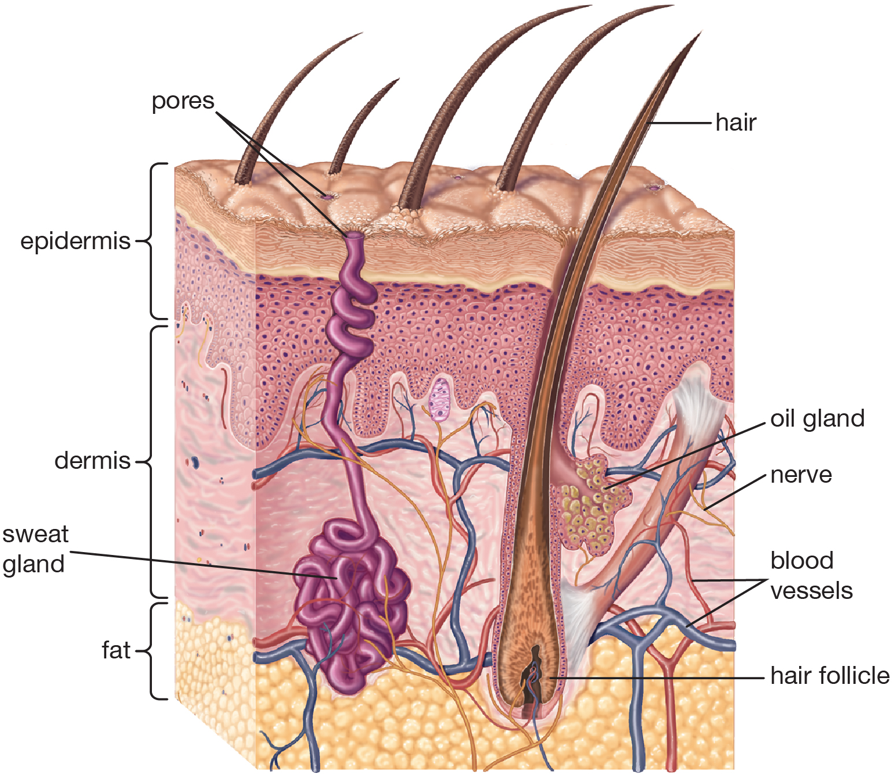Let’s Talk!
We live in an age when there are countless ways to stay connected with others. Modern technology like cell phones, laptops, and iPads give us 24-hour access to applications such as e-mail, instant messaging, Facebook, and Skype.
People tend to spend more time communicating online than engaging in face-to-face conversations and having physical contact. However, according to some researchers, touch may have a profound impact on our health and personal relationships.
Let’s explore this idea…
According to Wikipedia, the Latin word cutis means “skin”. Therefore, the literal translation of cutaneous is “of the skin”. The skin is only 2-3 mm thick and composed of three layers of cells, yet it is the largest organ in the human body.
 The skin has many functions: insulation, body temperature regulation, infectious disease protection, evaporation control, absorption, waste excretion, vitamin D production, touch perception, communication, and aesthetics.
The skin has many functions: insulation, body temperature regulation, infectious disease protection, evaporation control, absorption, waste excretion, vitamin D production, touch perception, communication, and aesthetics.
Anthropologist Nina Jablonski Ph.D. points out that compared to other primates, human skin is naked, extremely sensitive, contains sweat glands, comes in a wide range of colours due to melanin, and used for artistic expression (i.e., tattoos).
Jablonski explains that the sense of touch is the second most important sense for our information gathering after the vision. Humans are equipped with very dexterous hands, and our skin contains various nerve cells that process information about the environment.
A large portion of the brain’s parietal lobe is devoted to processing physical sensations; more specifically the hands, tongue, and lips. This information is sent to our brain, which in turn gives meaning to the sensation.
Touch is the first language of love that we learn as infants. Our mother’s skin and warmth as she held us close to her chest were very reassuring and nurturing. In fact, babies that are touch-deprived often fail to thrive and some may even die.
 The memory of love and security linked to touch as infants may prompt us as adults to want to be touched by our intimates when we experience strong negative emotions.
The memory of love and security linked to touch as infants may prompt us as adults to want to be touched by our intimates when we experience strong negative emotions.
Social psychologist Dacher Ketlner Ph.D. noted that touch communicates human emotions and produces trusting behaviours in people. For example, individuals who are touched on the shoulder before being asked to do a task are more likely to complete the task.
In the animal kingdom, primates often groom each other to reinforce social bonds, promote peace after an argument, or reassure their young. Ironically, adult humans may instead pay for grooming in the form of massages and facials.
According to Lance Luria M.D., skin-on-skin contact (i.e., holding a person’s hand) increases the level of the bonding hormone oxytocin and decreases the stress hormone cortisol. Hand holding lowers activity in certain brain areas such as the amygdala and locus coeruleus associated with pain and anxiety. Touch also reduces blood pressure, increases pain threshold, strengthens the immune system, and shifts the metabolism to a restorative mode of growth, healing, and nutrient storage.
People vary in their preferred frequency of touch based on a number of factors such as age, sex, gender, culture, and religion. For instance in Argentina, even when meeting for the first time, both men and women greet each other by kissing on both cheeks. By contrast, Muslim women are not allowed to shake hands with men who are strangers. Moreover, people enjoy being touch in different areas of their bodies by certain individuals.
However, researcher Helena Backlund Wasling Ph.D. reported that humans usually respond positively to light, warm touch (30 degrees Celsius) applied at an average speed. Interestingly, 30 degrees Celsius is the temperature of human skin.
In the context of romantic relationships, touch has added significance. When we are attracted to a person, we are often compelled to touch them and be touched by them. The closer the emotional bond, the greater the frequency, duration, and familiarity with that particular touch. In fact, Ketlner observed that blindfolded women can easily identify their husbands’ hand touch when touched by various men.
In North America, it is more socially acceptable for two adult heterosexual women to be physically affectionate with one another than their male counterparts. Therefore, many men turn to their romantic partners to satisfy their need for touch.
Unfortunately, there is an assumption that touch by our mate has to lead to sexual intercourse. Some women may become resentful that their partners only touch them when they want sex. Consequently, non-sexual touch within romantic relationships may play an important role in building intimacy and trust as well as enhancing sexual fulfillment.
Some health care professionals recognize the importance of touch in speeding up recovery from various illnesses. For example, author and Certified Oncology Massage Therapist Julie Mills-Watson recommends touch for post-surgery and cancer patients as well as the elderly.
According to Mills-Watson, touch increases appetite and sleep quality while reducing disease relapse, stress, and anxiety. Patients can be safely touched on the head, hands, and feet, and should be lightly touched for 10-20 minutes.
Some organizations offer touch in the form of free hugs to strangers. Some people take this concept to another level and are professional cuddlers who charge about $80/hour to cuddle with their clients. Although there is skin-to-skin contact, kissing on the mouth and sexual touch is strictly prohibited.
 One such organization is London-based Guerrilla Hugs founded in 2010 by social worker Majella Greene M.Sc. It is a small group of people who stay for about 1 hour at various locations within London and give free hugs to passersby. Greene’s goal is to increase platonic touch, wellness, and happiness in people in the hope that it has a ripple effect on others.
One such organization is London-based Guerrilla Hugs founded in 2010 by social worker Majella Greene M.Sc. It is a small group of people who stay for about 1 hour at various locations within London and give free hugs to passersby. Greene’s goal is to increase platonic touch, wellness, and happiness in people in the hope that it has a ripple effect on others.
Skin gives us the sense of touch. It is one of the main senses that inform us about our environment, but also has many positive effects. Touch enhances love and cooperation between individuals as well as improving overall health.
There are cultural, gender, religious, and age differences as to who, when, where, and how touch is appropriate. In the context of romantic relationships, non-sexual touch plays a central role in nourishing the bond between lovers.
Furthermore, health care professionals and some grass-root organizations such as Guerrilla Hugs now offer platonic touch to their clients. As the health benefits of touch become more commonplace, perhaps people will incorporate regular touch in their lives.
Literary Truths
Here are other interesting facts about the skin and the sense of touch:
- Touching people on the forearm activates the reward system in their brain, and it is as pleasurable as eating chocolate.
- Based on the research by Dacher Ketlner Ph.D. at the University of California, blindfolded people are able to recognize emotions such as compassion, love, and gratitude through light touch of their forearm. However, blindfolded men were unable to recognize their wives’ hand touch when touched by a series of women.
- Ketlner observed in his research that when women tried to communicate anger by touching men on their forearm, men were unable to discern this emotion. Conversely, when men tried to communicate compassion by touching women on their forearm, women were unable to discern this emotion.
- In Hindu and Islamic cultures, touching a person with the left hand is usually perceived as an insult.
- Within the same population, women tend to have lighter skin colour than men because of their greater need for calcium during pregnancy and breastfeeding. Their lighter complexion allows for more efficient production of vitamin D through sunlight.
Truth in Motion
References
Cultural Etiquette and Touch: https://www.youtube.com/watch?v=5PGCkSoy5nk
Fight off Loneliness with touch – Helena Backlund Wasling – TEDxGöteborg: https://www.youtube.com/watch?v=omIWt3xq648
Human Skin: https://en.wikipedia.org/wiki/Human_skin
Importance Of Touch: https://www.youtube.com/watch?v=7rBZRyReO48
The Importance Of Touch: https://www.youtube.com/watch?v=e32SimoPtbc
Nina Jablonski: Power of Touch: https://www.youtube.com/watch?v=SaR8wOctRzs
On the Trail of the Free Hugs Founder: https://www.theguardian.com/lifeandstyle/2012/sep/02/free-hug-movement-founder
Picture 1: https://kids.britannica.com/kids/assembly/view/89672
Picture 2: http://caho-hospitals.com/wp-content/uploads/2013/12/iStock_000020081357Large.jpg
Picture 3: https://weheartit.com/entry/170451522
Picture 4: http://www.guerrillahugs.com
The Power of Touch: https://www.youtube.com/watch?v=xj_ZGHBWYVw
Relationships and Physical Touch: https://www.youtube.com/watch?v=r_3CqEF7Ll8
TEDxBerkeley – Dacher Keltner – 04/03/10: https://www.youtube.com/watch?v=KsFxWSuu_4I


